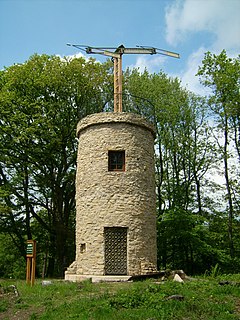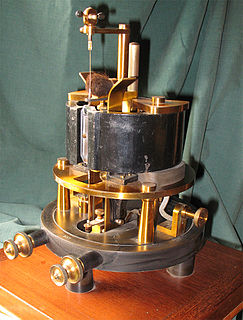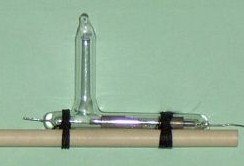
An electrical telegraph was a point-to-point text messaging system, used from the 1840s until the mid 20th century when it was slowly replaced by other telecommunication systems. At the sending station switches connected a source of current to the telegraph wires. At the receiving station the current activated electromagnets which moved indicators, providing either a visual or audible indication of the text. It was the first electrical telecommunications system and the most widely used of a number of early messaging systems called telegraphs, that were devised to communicate text messages more rapidly than by physical transportation. Prior to the electric telegraph, semaphore systems were used, including beacons, smoke signals, flag semaphore, and optical telegraphs for visual signals to communicate over distances of land.

Jean-Maurice-Émile Baudot, French telegraph engineer and inventor of the first means of digital communication Baudot code, was one of the pioneers of telecommunications. He invented a multiplexed printing telegraph system that used his code and allowed multiple transmissions over a single line. The baud unit was named after him.

Morse code is a method used in telecommunication to encode text characters as standardized sequences of two different signal durations, called dots and dashes, or dits and dahs. Morse code is named after Samuel Morse, one of the inventors of the telegraph.

Telegraphy is the long-distance transmission of messages where the sender uses symbolic codes, known to the recipient, rather than a physical exchange of an object bearing the message. Thus flag semaphore is a method of telegraphy, whereas pigeon post is not. Ancient signalling systems, although sometimes quite extensive and sophisticated as in China, were generally not capable of transmitting arbitrary text messages. Possible messages were fixed and predetermined and such systems are thus not true telegraphs.

Wireless telegraphy or radiotelegraphy is transmission of telegraph signals by radio waves. Before about 1910, the term wireless telegraphy was also used for other experimental technologies for transmitting telegraph signals without wires. In radiotelegraphy, information is transmitted by pulses of radio waves of two different lengths called "dots" and "dashes", which spell out text messages, usually in Morse code. In a manual system, the sending operator taps on a switch called a telegraph key which turns the transmitter on and off, producing the pulses of radio waves. At the receiver the pulses are audible in the receiver's speaker as beeps, which are translated back to text by an operator who knows Morse code.

A galvanometer is an electromechanical measuring instrument for electric current. Early galvanometers were uncalibrated, but improved versions, called ammeters, were calibrated and could measure the flow of current more precisely.

A mirror galvanometer is an ammeter that indicates it has sensed an electric current by deflecting a light beam with a mirror. The beam of light projected on a scale acts as a long massless pointer. In 1826, Johann Christian Poggendorff developed the mirror galvanometer for detecting electric currents. The apparatus is also known as a spot galvanometer after the spot of light produced in some models.

Transatlantic telegraph cables were undersea cables running under the Atlantic Ocean for telegraph communications. Telegraphy is now an obsolete form of communication and the cables have long since been decommissioned, but telephone and data are still carried on other transatlantic telecommunications cables. The first cable was laid in the 1850s from Valentia in western Ireland to Bay of Bulls, Trinity Bay, Newfoundland. The first communications occurred on 16 August 1858, but the line speed was poor and efforts to improve it caused the cable to fail after three weeks.

The coherer was a primitive form of radio signal detector used in the first radio receivers during the wireless telegraphy era at the beginning of the 20th century. Its use in radio was based on the 1890 findings of French physicist Édouard Branly and adapted by other physicists and inventors over the next ten years. The device consists of a tube or capsule containing two electrodes spaced a small distance apart with loose metal filings in the space between. When a radio frequency signal is applied to the device, the metal particles would cling together or "cohere", reducing the initial high resistance of the device, thereby allowing a much greater direct current to flow through it. In a receiver, the current would activate a bell, or a Morse paper tape recorder to make a record of the received signal. The metal filings in the coherer remained conductive after the signal (pulse) ended so that the coherer had to be "decohered" by tapping it with a clapper actuated by an electromagnet, each time a signal was received, thereby restoring the coherer to its original state. Coherers remained in widespread use until about 1907, when they were replaced by more sensitive electrolytic and crystal detectors.
A telegraph code is one of the character encodings used to transmit information by telegraphy. Morse code is the best-known such code. Telegraphy usually refers to the electrical telegraph, but telegraph systems using the optical telegraph were in use before that. A code consists of a number of code points, each corresponding to a letter of the alphabet, a numeral, or some other character. In codes intended for machines rather than humans, code points for control characters, such as carriage return, are required to control the operation of the mechanism. Each code point is made up of a number of elements arranged in a unique way for that character. There are usually two types of element, but more element types were employed in some codes not intended for machines. For instance, American Morse code had about five elements, rather than the two of International Morse Code.

Alexander Bain was a Scottish inventor and engineer who was first to invent and patent the electric clock. He invented the Telegraph Clock, which was a technology of synchronizing many electric clocks placed anywhere in the world; they would all have the exact same time. He also invented and patented the technology of the facsimile machine for scanning images and transmitting them across telegraph lines hundreds of miles away.

A chart recorder is an electromechanical device that records an electrical or mechanical input trend onto a piece of paper. Chart recorders may record several inputs using different color pens and may record onto strip charts or circular charts. Chart recorders may be entirely mechanical with clockwork mechanisms, electro-mechanical with an electrical clockwork mechanism for driving the chart, or entirely electronic with no mechanical components at all.

American Morse Code — also known as Railroad Morse—is the latter-day name for the original version of the Morse Code developed in the mid-1840s, by Samuel Morse and Alfred Vail for their electric telegraph. The "American" qualifier was added because, after most of the rest of the world adopted "International Morse Code," the companies that continued to use the original Morse Code were mainly located in the United States. American Morse is now nearly extinct—it is most frequently seen in American railroad museums and American Civil War reenactments—and "Morse Code" today virtually always means the International Morse which supplanted American Morse.

In the late 1800s, telegraphy was developing as a way for distant communication. Messages were converted to dots and dashes that were sent as electric pulses and could be converted to sound or visual signals at the distant site. That conversion was done by a coil in a galvanometer, which had a limited frequency. Clément Adair, a French engineer, replaced the coil with a much faster wire or "string" producing the first string galvanometer. Augustus Waller had discovered electrical activity from the heart and produced the first electrocardiogram in 1887. But his equipment was slow. Physiologists worked to find a better instrument. In 1901, Willem Einthoven described the science background and potential utility of a string galvanometer, stating "Mr. Adair as already built an instrument with a wires stretched between poles of a magnet. It was a telegraph receiver." Although Einthoven is sometimes credited with inventing it, he did not invent the string galvanometer. He was a leader in applying the string galvanometer to physiology and medicine, leading to today's electrocardiography. Einthoven was awarded the 1924 Nobel prize in Physiology or Medicine for his work.

Froment's "mouse mill" motor was an early form of electric motor, also known as the Revolving Armature Engine. It has similarities to both the synchronous motor and the contemporary stepper motor.

A needle telegraph is an electrical telegraph that uses indicating needles moved electromagnetically as its means of displaying messages. It is one of the two main types of electromagnetic telegraph, the other being the armature system as exemplified by the telegraph of Samuel Morse in the United States. Needle telegraphs were widely used in Europe and the British Empire during the nineteenth century.

The Wheatstone system was an automated telegraph system that replaced a human operator with machines capable of sending and recording Morse code at a consistent fast rate. The system included a perforator, which prepared punched paper tape called a Wheatstone slip, a transmitter that read the tape and converted the symbols into dots and dashes encoded as mark and space electric currents on the telegraph line, and a receiver at the other end of the telegraph line that printed the Morse symbols. The system was invented by Charles Wheatstone. Enhancements could be made so that it was a duplex system, able to send and receive on the same line simultaneously.

The British and Irish Magnetic Telegraph Company was founded by John Brett in 1850. The Magnetic was the principal competitor to the largest telegraph company in the United Kingdom, the Electric Telegraph Company. The Magnetic was the leading company in Ireland, while the Electric was the leading company in mainland Britain. Between them, they dominated the market until the telegraph was nationalised in 1870.

Major Philip Cardew, was an English army officer in the Royal Engineers. Engaged in the application of electricity to military purposes, he designed innovations in electrical engineering.

Earth-return telegraph is the system whereby the return path for the electric current of a telegraph circuit is provided by connection to the earth through an earth electrode. Using earth return saves a great deal of money on installation costs since it halves the amount of wire that is required, with a corresponding saving on the labour required to string it. The benefits of doing this were not immediately noticed by telegraph pioneers, but it rapidly became the norm after the first earth-return telegraph was put into service by Carl August von Steinheil in 1838.























